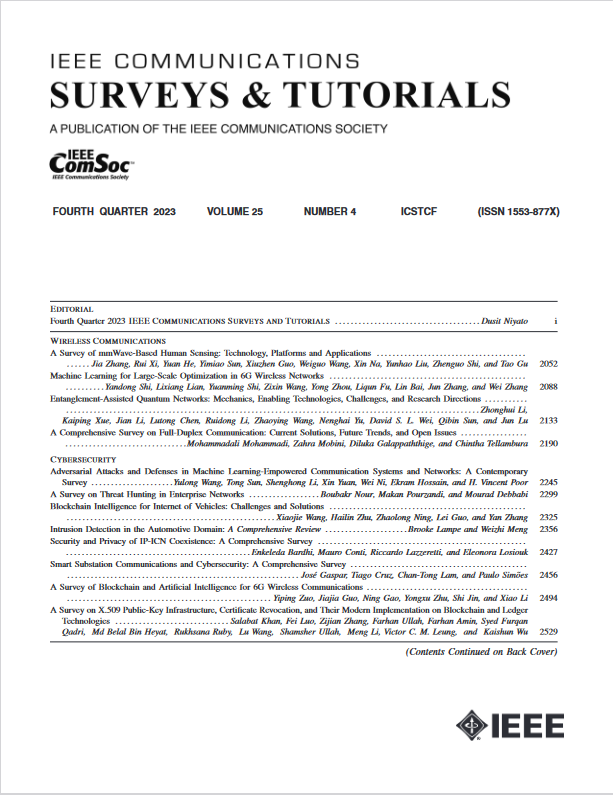IP-ICN共存的安全性和隐私性:综合调查
IF 34.4
1区 计算机科学
Q1 COMPUTER SCIENCE, INFORMATION SYSTEMS
引用次数: 1
摘要
今天的互联网用户数量庞大,对数据的需求不断增加,这是安全和隐私问题引入限制的主要原因。为了克服这些限制,建议从以主机为中心转向以数据为中心,在这种情况下,以信息为中心的网络(Information-Centric Networking, ICN)代表了一个很有前途的解决方案。然而,用ICN扰乱当前的互联网网络层——即互联网协议(IP)——是一项具有挑战性和昂贵的任务,因为它需要互联网服务提供商(isp)、骨干网和自治服务(AS)之间的全球协调。因此,研究者预测当前互联网的更替过程将通过IP和ICN的共存进行过渡。从这个角度来看,新的架构结合了IP和ICN协议。然而,只有少数被提议的体系结构提供了基于设计的安全性特性。因此,本文通过横向比较三种部署方法(即覆盖、底层和混合)中的SP特性,以及纵向比较10种考虑的SP特性,首次对最先进的IP-ICN共存架构进行了全面的安全和隐私(SP)分析。最后,文章阐明了IP-ICN共存的开放问题和可能的未来方向。我们的分析表明,大多数架构都不能提供几个SP特性,包括数据和流量的机密性、可用性和通信的匿名性。因此,本文将展示当前和未来协议栈在共存阶段的安全组合,而互联网肯定会走过这一阶段。本文章由计算机程序翻译,如有差异,请以英文原文为准。
Security and Privacy of IP-ICN Coexistence: A Comprehensive Survey
Today’s Internet is experiencing a massive number of users with a continuously increasing need for data, which is the leading cause of introduced limitations among security and privacy issues. To overcome these limitations, a shift from host-centric to data-centric is proposed, and in this context, Information-Centric Networking (ICN) represents a promising solution. Nevertheless, unsettling the current Internet’s network layer – i.e., Internet Protocol (IP) – with ICN is a challenging, expensive task since it requires worldwide coordination among Internet Service Providers (ISPs), backbone, and Autonomous Services (AS). Therefore, researchers foresee that the replacement process of the current Internet will transition through the coexistence of IP and ICN. In this perspective, novel architectures combine IP and ICN protocols. However, only a few of the proposed architectures place the security-by-design feature. Therefore, this article provides the first comprehensive Security and Privacy (SP) analysis of the state-of-the-art IP-ICN coexistence architectures by horizontally comparing the SP features among three deployment approaches – i.e., overlay, underlay, and hybrid – and vertically comparing among the ten considered SP features. Lastly, the article sheds light on the open issues and possible future directions for IP-ICN coexistence. Our analysis shows that most architectures fail to provide several SP features, including data and traffic flow confidentiality, availability, and anonymity of communication. Thus, this article shows the secure combination of current and future protocol stacks during the coexistence phase that the Internet will definitely walk across.
求助全文
通过发布文献求助,成功后即可免费获取论文全文。
去求助
来源期刊

IEEE Communications Surveys and Tutorials
COMPUTER SCIENCE, INFORMATION SYSTEMS-TELECOMMUNICATIONS
CiteScore
80.20
自引率
2.50%
发文量
84
审稿时长
6 months
期刊介绍:
IEEE Communications Surveys & Tutorials is an online journal published by the IEEE Communications Society for tutorials and surveys covering all aspects of the communications field. Telecommunications technology is progressing at a rapid pace, and the IEEE Communications Society is committed to providing researchers and other professionals the information and tools to stay abreast. IEEE Communications Surveys and Tutorials focuses on integrating and adding understanding to the existing literature on communications, putting results in context. Whether searching for in-depth information about a familiar area or an introduction into a new area, IEEE Communications Surveys & Tutorials aims to be the premier source of peer-reviewed, comprehensive tutorials and surveys, and pointers to further sources. IEEE Communications Surveys & Tutorials publishes only articles exclusively written for IEEE Communications Surveys & Tutorials and go through a rigorous review process before their publication in the quarterly issues.
A tutorial article in the IEEE Communications Surveys & Tutorials should be designed to help the reader to become familiar with and learn something specific about a chosen topic. In contrast, the term survey, as applied here, is defined to mean a survey of the literature. A survey article in IEEE Communications Surveys & Tutorials should provide a comprehensive review of developments in a selected area, covering its development from its inception to its current state and beyond, and illustrating its development through liberal citations from the literature. Both tutorials and surveys should be tutorial in nature and should be written in a style comprehensible to readers outside the specialty of the article.
 求助内容:
求助内容: 应助结果提醒方式:
应助结果提醒方式:


